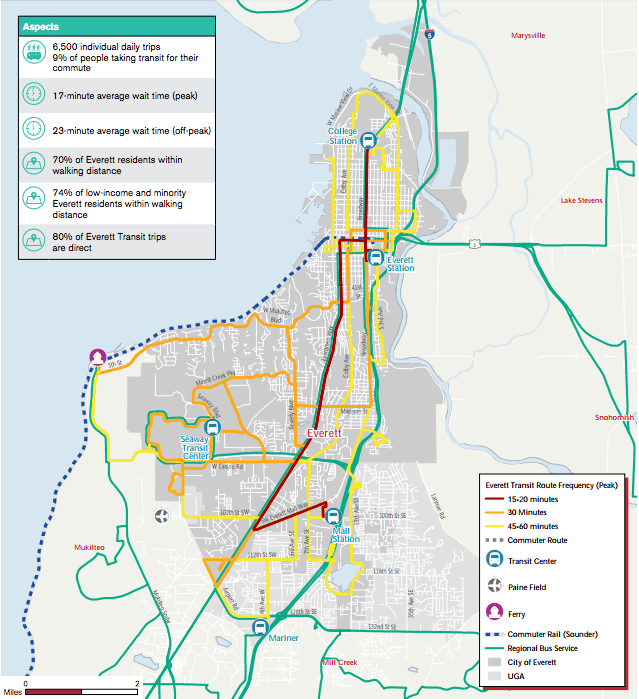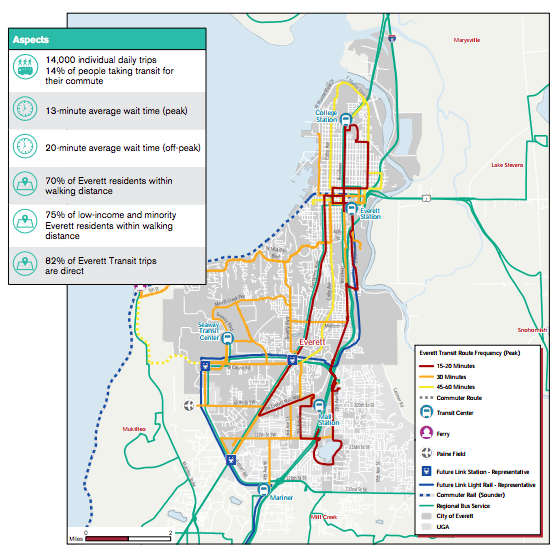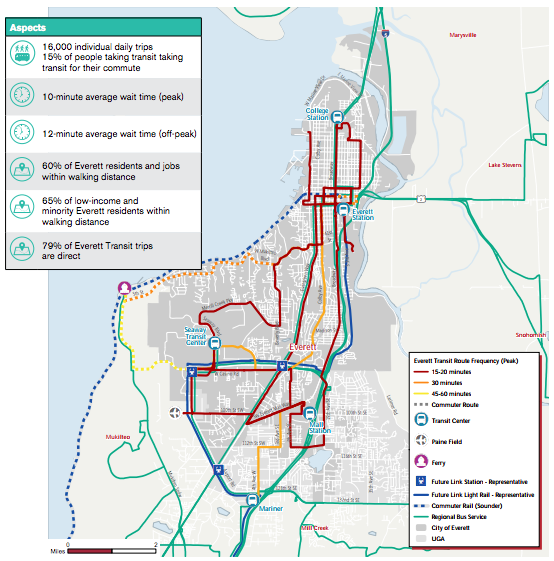Everett’s effort to develop a 20-year, long-term strategy for its city-operated bus system is moving forward with two competing options. One option would add service coverage to more areas of Everett, another would bolster frequency across a smaller set of corridors. The tradeoffs between the two options include wait times, walking distance, equity, and directness to destinations. Both options would greatly increase ridership over the baseline numbers of today and virtually every aspect of service would improve in some way. Everett also plans to ensure that its transit services directly connect with regional investments in high capacity transit (e.g., Swift, North Link, and North Sounder).
The baseline service for Everett is highly dispersed and low frequency across the city. Only one route (Route 7) stretching from Everett Community College to the Everett Mall via Evergreen Way meets the standard of frequent service. Buses come every 15 minutes during most peak and midday hours on weekdays. The line also acts as a shadow local line to the Swift Blue line on Evergreen Way. Other routes fill in the gaps with low to modest service levels, many of which primarily provide circulator and commuter functions. Routes tend to be indirect in many cases making substantial diversions from main corridors, operating in one-way loops, and circling their own paths. Still, the baseline service does provide a high level of coverage to communities in Everett and 6,500 daily trips.

The coverage option places a strong emphasis on a broad network of routes in Everett, though some consolidation of corridors is considered. Two corridors would form a north-south spine from North Everett to South Everett via the city center. The future Link extension to Everett factors somewhat into the plan since local and frequent routes would tie into the proposed light rail stations. Despite this, frequency off-peak would generally be about 20 minutes with many routes being half-hourly or more. Only during peak periods would average wait times be reduced to 13 minutes or so.
There is a variety of positive attributes to the coverage option. More areas in Everett would be served by transit allowing shorter walks to buses than the frequency option. Because of this, more residents would be directly served by transit. 75% of low-income and minority residents would be within walking distance of a bus stop while 70% of all Everett residents would be within walking distance. These numbers suggest high access and equity by households covered by the proposed service. However, it’s projected to get lower total daily ridership than the frequency option.

The frequency option is focused on a fewer number of corridors and high levels of service throughout the day. Peak period service would average every 10 minutes while off-peak service would every 12 minutes. In addition to core north-south routes on Evergreen Way and Broadway, this option would help spread frequent corridors to Paine Field, Seahurst, Boeing, Lowell, and Port of Everett using a mix of new east-west and north-south corridors. Most of the corridors would directly integrate with light rail and other transit connections to promote regional access.
The tradeoff here is that fewer residents and jobs would be within walking distance of transit, but daily ridership would be about 14% higher than the coverage option. The higher level of frequency would also likely promote transit as a primary mode for riders as opposed to just a commuting or special events tool. This attribute is not represented in the analysis.

Simplifying the options at a higher level, Everett Transit has distilled key aspects of the options into a variety of metrics:
| Aspects | Frequency Option | Coverage Option | Existing Service |
|---|---|---|---|
| Number of daily rides by passengers | 16,000 | 14,000 | 6,500 |
| Percent of people that commute by transit | 15% | 14% | 9% |
| Frequency during peak commute periods | 10 minutes | 13 minutes | 17 minutes |
| Frequency during midday, nights, and weekends | 12 minutes | 20 minutes | 23 minutes |
| Percent of people and jobs within walking distance of transit | 60% of residents | 70% of residents | 70% of residents |
| Percent of low-income and minority residents within walking distance of transit | 65% | 75% | 74% |
| Percent of trips providing direct connection to destination | 79% | 82% | 80% |
| Travel time examples (includes estimated wait, walk, and in-transit travel time) | |||
| Twin Creeks to Boeing | 40 to 45 minutes | 50 to 60 minutes | 60 to 70 minutes |
| Everett Mall to Downtown Everett | 35 to 40 minutes | 40 to 45 minutes | 45 to 50 minutes |
| Northwest Everett to Everett Station | 25 to 30 minutes | 20 to 25 minutes | 25 to 30 minutes |
Public comment on the service options is open through October 30th. An online open house and survey is available throughout the comment period providing an opportunity to dig deeper into the options and understand the tradeoffs between them. An in-person open house will also be held this Saturday (October 28th) from 4pm to 6pm at the Everett Mall.
Stephen is a professional urban planner in Puget Sound with a passion for sustainable, livable, and diverse cities. He is especially interested in how policies, regulations, and programs can promote positive outcomes for communities. With stints in great cities like Bellingham and Cork, Stephen currently lives in Seattle. He primarily covers land use and transportation issues and has been with The Urbanist since 2014.


